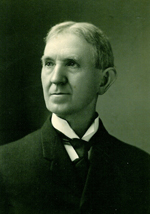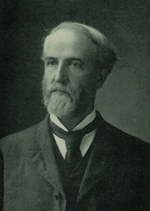Conflict: 1895-1899
Southern’s third president, William Whitsitt, was the first graduate of the school to become president. A church history professor, Whitsitt had joined the Southern faculty in 1872 when Basil Manly, Jr. left his teaching post to assume the presidency at Georgetown College. After his election to the presidency in 1895, Whitsitt oversaw the construction of Levering Gymnasium, presided over an increasing enrollment, and expanded the missions curriculum. His feud with Landmark Baptists, however, defined his term.
In 1893 Whitsitt anonymously published an article in Johnson’s Universal Encyclopedia in which he argued that Roger Williams, founder of the first church in America, was baptized by sprinkling. Whitsitt also claimed that immersion as a practice among Baptists originated among English Baptists in 1641. When his authorship became known, the Landmark Baptists roared in response. Landmarkers believed that a succession of immersionist Baptists was necessary for the existence of true churches, and that this succession in fact existed from apostolic times until their day. Whitsitt’s claim that the practice of immersion debuted sixteen centuries after the apostles would mean that true churches no longer existed.
In public literature, Landmarkist leaders T. T. Eaton, pastor of Louisville’s influential Walnut Street Baptist Church, and B. H. Carroll, pastor of the First Baptist Church of Waco, denounced Whitsitt’s view. Taken aback, Southern’s faculty rallied to their president’s aid and publicly declared their support in September 1896. The trustees next spoke up for Whitsitt, expressing a desire “to foster, rather than repress the spirit of earnest and reverent investigation.” (1) The storm surrounding Whitsitts’ article briefly subsided.
A year later, however, the powerful Carroll revived the controversy in an article entitled Back to the Realm of Discussion published in the Western Recorder. The author proposed that the convention sever Southern from the SBC for serving as a nursery for heretical ideas. Four SBC state conventions aligned with Carroll and called for Whitsitt’s resignation.
Though Whitsitt himself wished to stay at the seminary, many forecast that his presence at Southern would cause great damage to the institution. In May 1899, the trustees accepted Whitsitt’s resignation. Though the embattled president moved on, bitterness from the fight lingered. The controversy left a lasting impression on the seminary.
(1) Mueller, A History of Southern, 165.


